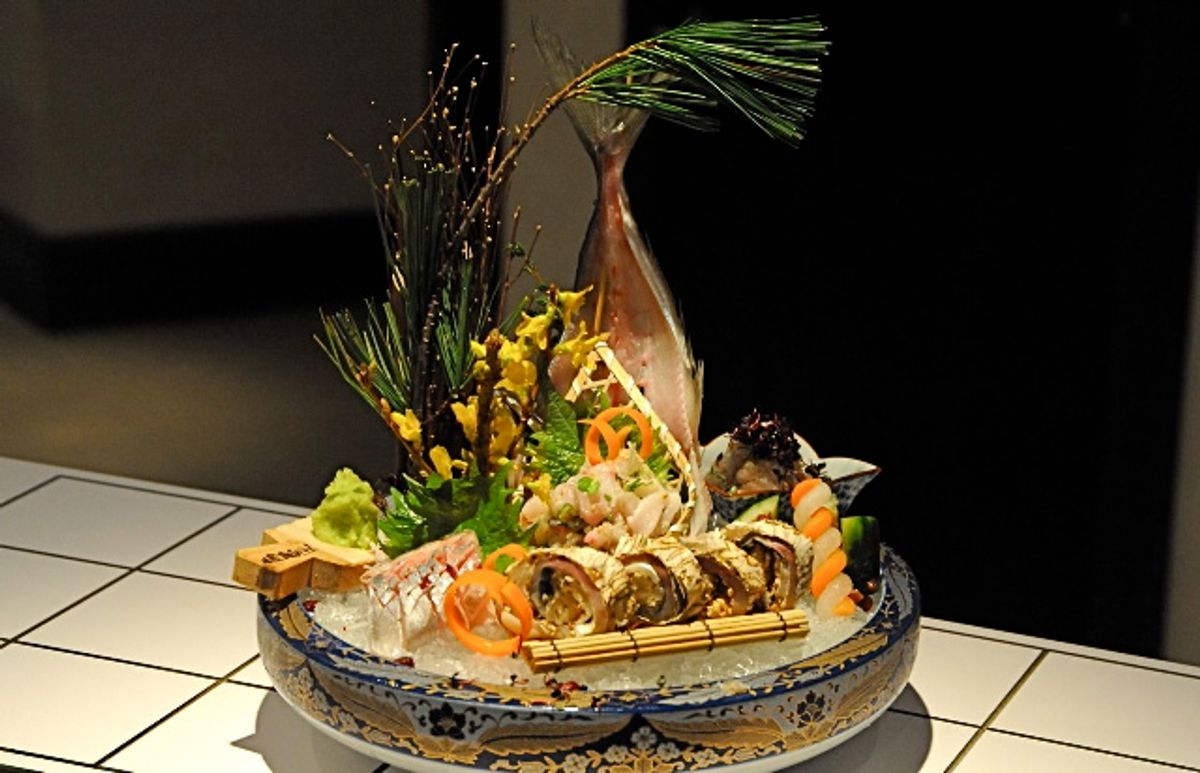Jackfish, which the Japanese call aji, can come on like a revelation. It hints at the fatty richness of yellowtail, but with a cleaner flavor, a scallop-y sweetness, and a ringing umamiliciousness. Yes, I just wrote the word "umamiliciousness."
It's gorgeous on its own, but may be even better as a backdrop for the sweet, earthy flavors of miso, as it is here in namerou, a dish whose name means "to lick," as in, "You're going to lick this plate after it's all gone." No, really. That's why they call it that.
Most simply, namerou can be fish dressed with miso, ginger, a few other aromatics, but the technique is interesting: a chopping/pounding process that turns the meat into a sort of instant pâté. Except it's raw. So it's like a raw pâté. That doesn't sound so good. A raw fish sausage? Oh, forget it. Just make it and eat it. It'll blow your mind, and maybe you'll do a better job of describing it than I can.
Miso-jackfish tartare (Namerou)
If you can't find jackfish (aji), this recipe also works wonderfully with fresh sardines, squid, horse mackerel, mackerel pike, mackerel and sea bream.
Per person:
3 ounces jackfish filet, scaled thoroughly (or skinned, as appropriate with mackerel)
1 teaspoon white miso paste
1 shiso leaf, chiffonade
1 pinch thinly sliced scallions (green parts)
1 pinch finely minced peeled ginger
1 pinch sesame seeds
¼-inch slice myoga* (Japanese ginger) finely minced (if you can find it)
- Dice the fish into roughly ½-inch pieces.
- Leaving the fish on the cutting board, add the miso, spreading it somewhat over the fish with the side of your knife. Now chop the two together. Don't hold back! You can resharpen your knife later. Scrape up and fold the fish on itself after every few chops to thoroughly combine the miso.
- As you chop, keep an eye on the meat -- as it gets finer, the fish will start to get a little tacky. What's happening is that the proteins are unraveling and looking for other proteins to stick to. When you start to notice that tackiness, sprinkle on the other ingredients one by one, separated by a few chops, just enough to start to incorporate them.
- Now turn your knife upside down, and chop at the fish with the flat spine of the blade. In smashing the fish, you're encouraging that protein action, creating a tartar with some integrity; it will want to hold together a bit. It's up to you how far you want to take this; in theory, you can keep pounding until it's a smooth paste. Chef Suzuki serves it at the point where the whole mass likes to hold together -- where you could form it into a meatball -- but where about ¼-inch dice of fish are still visible, giving a yielding resistance when you chew.
- To serve: The namerou is delicious served like this, each chew bringing out a different flavor, or you can lightly broil it: Mound it on a wooden spoon or paddle and wave it over the flame of your stove until you get slight spots and specks of char. The intention isn't to give it a crust or cook it through, but to lightly cook the outer layer. The contrasting texture of firm, cooked fish and yielding core is lovely, and the slight charring brings out the earthy, smoky flavors of the miso. Gorgeous stuff.
* Myoga is not, in fact, a relative of ginger, but a Japanese bud with pinkish skin, a very floral aroma and a mild, shallot-like bite. It's lovely, but if you can't find it, don't let that stop you from making namerou.
Recipe by Toshio Suzuki, as presented at Mastering Fish the Japanese Way, by the Gohan Society



Shares